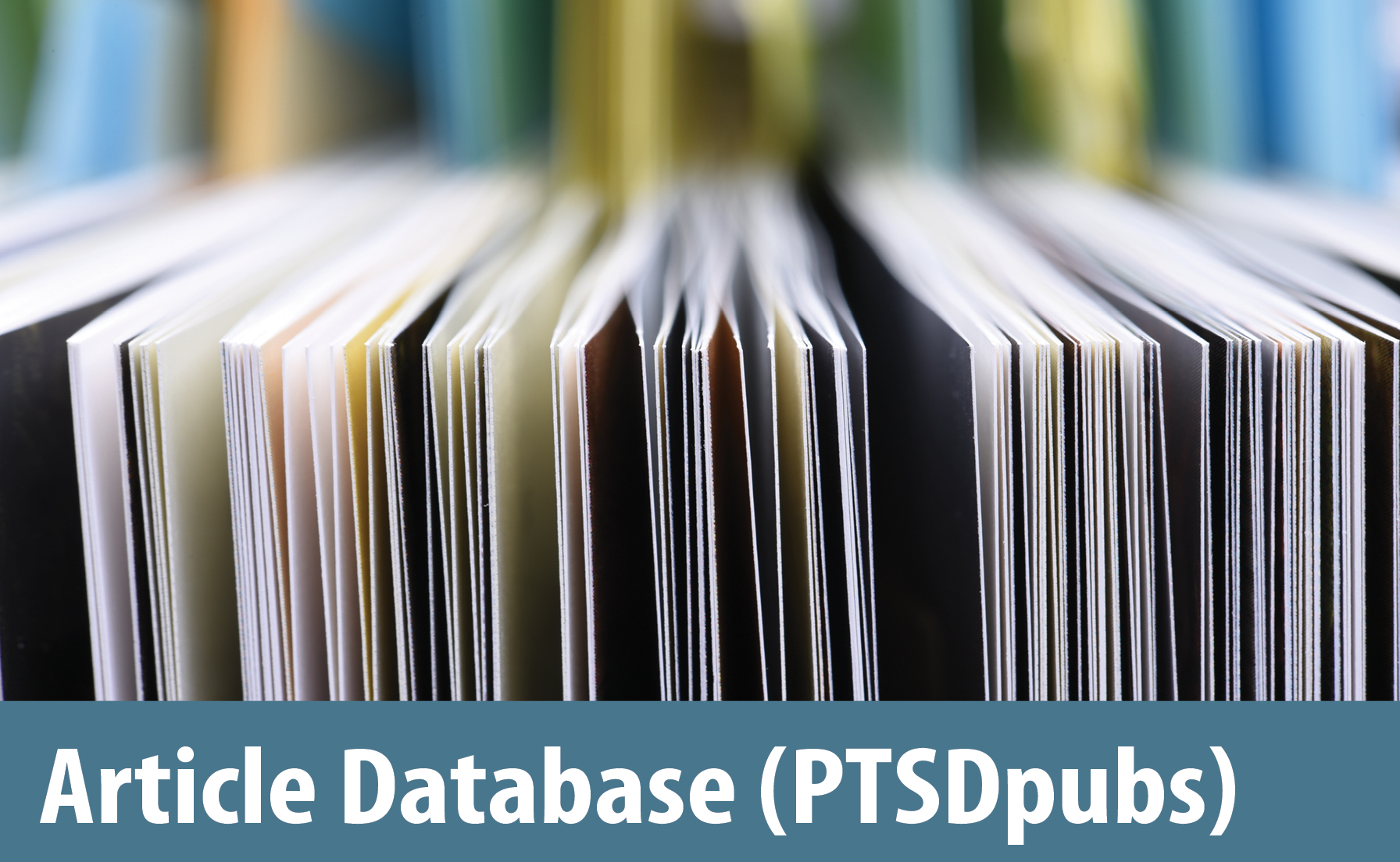Military Sexual Trauma
Military Sexual Trauma
What Is Military Sexual Trauma?
Military sexual trauma (MST) refers to sexual harassment or sexual assault that occurs during an individual's military service. MST can occur while someone is on or off duty, or on or off base. Perpetrators of MST can be anyone—for example, they can be of any sex, and can be military personnel or civilians, superiors or subordinates in the chain of command, strangers, friends or intimate partners.
MST includes any sexual activity in which someone was involved against their will or when they were unable to say "no". For example:
- Being physically forced into sexual activities
- Being pressured or coerced into sexual activities, such as with threats or with promises of rewards for being cooperative
- Experiencing sexual contact or activities without consent, such as while asleep or intoxicated
- Being touched or grabbed in a sexual way that felt uncomfortable, including during "hazing" experiences
- Experiencing unwanted sexual comments or advances that felt threatening
In This Article
How Common Is Military Sexual Trauma?
As is the case with individuals who experience other forms of sexual trauma, many MST survivors remain silent about their experiences, and this can complicate efforts to estimate the prevalence of MST. Further, prevalence estimates may vary substantially based on the wording of questions asked, the timeframe asked about (e.g., past year, any time during military service), the context in which the questions are asked (e.g., research survey, by a provider in a health care setting), level of confidentiality involved, and other factors. One key source of prevalence information is the Department of Defense's biennial survey of current service members. The most recent survey in 2018 found that 6.2% of active-duty women and 0.7% of active-duty men surveyed had experienced sexual assault in the previous year, and 24.2% of active-duty women and 6.3% of active-duty men surveyed had experienced sexual harassment in the previous year (1). Data from the Department of Veterans Affairs' (VA) universal screening program, in which all former service members seen for health care in VA are asked about experiences of MST, are also informative. These data reveal that when screened, about 1 in 3 women and 1 in 50 men report having experienced MST at some point during their military service (2).
People of all sexes, sexual orientations, ages, racial and ethnic backgrounds, physical sizes and appearances, and branches and eras of service have experienced MST. Identifying and comparing prevalence estimates for specific subgroups of people is inherently challenging, but individuals from certain marginalized groups do appear to be at increased risk for experiencing MST, with risk for sexual assault having been studied more extensively than risk for sexual harassment.
- Gender is the factor most strongly and consistently related to risk for experiencing MST, as women experience MST in higher proportions than men (3).
- Gender identity has further relevance. Transgender service members are also at higher risk for experiencing MST compared to cisgender service members (i.e., those whose gender identity is the same as their sex as assigned at birth) (4).
- Regarding sexual orientation, lesbian, bisexual and gay service members also appear to experience MST at higher proportions than heterosexual individuals (5,6).
- Research examining the relative risk for people of color is less clear. When differences across racial and ethnic groups have been identified, they have been hypothesized to be better accounted for by the confounding influences of younger age, lower rank or decreased likelihood of formal reporting (7,8). Indeed, factors such as younger age, fewer years of military service, and lower pay grade are commonly found to be associated with increased risk for experiencing MST (9,10).
Although research has tended to focus on examination of each of these risk factors in isolation, it is important to consider the intersectionality across risk factors, as many service members will identify with more than one marginalized identity.
What Are Some Unique Aspects of Sexual Trauma During Military Service?
MST involves victimization and profound violation in a context where an individual typically expects others to be "service members in arms," and where there is a need to depend on others to be safe (particularly in combat situations) and to meet other basic needs. Survivors often report that experiencing MST led to a rupture in these bonds and their sense of trust, even as survivors needed to continue in an environment that requires a dependence on these bonds. This tension often creates strong feelings of powerlessness and helplessness and can lead to feelings of betrayal. In addition, MST most often occurs in a setting where the survivor lives and works and, in many cases, this means that they must continue to live and work closely with their perpetrators. This can lead to chronic stress and fear and leave survivors at risk for additional victimization.
Because MST occurs in an individual's workplace, it can also disrupt their work functioning and career goals. In some cases, perpetrators may be supervisors who have the power to make decisions about work-related evaluations and promotions. Individuals who experience MST may avoid pursuing certain opportunities or request different work assignments to avoid contact with their perpetrator or the perpetrator's friends. This may affect the survivor's career trajectory. In the end, survivors may feel forced to choose between continuing their military career, which could mean continuing to interact with or be dependent on their perpetrator, and sacrificing their career goals to avoid additional future victimization.
Military values can also affect survivors' own reactions to what they have experienced, in that victimization is strongly at odds with military ideals of strength and self-sufficiency. This dissonance can lead to intense feelings of shame and self-blame, along with identity struggles. It can also negatively impact survivors' willingness to disclose experiences of MST or to access treatment or other sources of help. Some individuals who have experienced MST may paradoxically evidence stellar work performance and related functioning because they are focused on hiding the impact of their experience.
Most military groups are characterized by high cohesion, particularly during deployments or in combat environments. While this level of solidarity is a positive aspect of military service for many service members, it can also lead those who have experienced MST to fear that sharing negative information about a fellow service member may damage their relationships with co-workers or put them at risk for retaliation. This can affect survivors' willingness to reach out to or depend on others for support (11). In these circumstances, unsupportive reactions from peers have the potential to significantly exacerbate the negative impacts of MST. However, when solidarity and cohesion are instead enlisted to promote support and protection for the survivor, those group dynamics have the potential to positively impact recovery.
How Does Military Sexual Trauma Impact Health and Well-Being?
Individuals vary in how they are impacted by experiences of MST. Some individuals will recover fully, with no long-term impacts on health and functioning. Others experience more significant or longstanding health impacts, and the severity of these impacts also will vary across individuals and within individuals over time. The intensity, duration and trajectory of responses are influenced by many factors, including the nature of the MST experience and individual and environmental risk and protective factors, such as age, availability of social support, and presence of additional stressors.
Like sexual trauma that occurs in other settings, many experiences of MST are high-impact traumatic events that meet the Criterion A threshold required for a diagnosis of posttraumatic stress disorder (PTSD); "exposure to actual or threatened death, serious injury or sexual violence," (12). Indeed, sexual violence is one of the traumatic events most strongly associated with PTSD (13,14). Experiences of sexual assault during military service are associated with PTSD to a degree that is comparable to, or larger than, the likelihood of a PTSD diagnosis associated with severe combat exposure or civilian sexual assault. Experiences of MST also increase risk for depressive disorders, anxiety disorders, eating disorders, dissociative disorders and substance use disorders (15). Experiences of MST are associated with increased risk of suicidal ideation and other behaviors (16). The negative impacts of MST also extend to physical health, with those who have experienced MST reporting more physical health symptoms, as well as more risky health behaviors (17). Thinking beyond medical or psychiatric diagnoses, those who have experienced MST may struggle with a range of other readjustment challenges including difficulties with close relationships, occupational adjustment and homelessness (18,19).
Specific dimensions of identity may affect individuals' experiences of MST, their reactions afterwards and their recovery. For example, MST is a form of violence against women who serve that can amplify other discriminatory messages they may have received (e.g., that they do not belong or do not conform enough to "warrior" ideals). Men may also face unique challenges in recovering from MST due to harmful and persistent myths about men and sexual assault (20), including the idea that men should always be strong and able to protect themselves. Perpetrators may also target members of historically marginalized groups (e.g., persons of color; LGBTQ+ individuals) due to perpetrators' own sexism, racism or homophobia. Perpetrators also may target members of marginalized groups because those with more limited societal power may be reluctant to fight back or disclose abuse due to realistic fears that their experiences won't be taken seriously (3,21). These patterns may be associated with more severe impacts on health and functioning in the aftermath of the MST, including challenges in overcoming (inaccurate) self-blame. Recovery among members of historically marginalized groups may be further complicated by identity-based stress and trauma before or after MST. A clear understanding of the impacts of MST on a particular individual, with consideration of the intersections among all of that individual's dimensions of identity, is critical for recognizing the most appropriate psychosocial treatments for that individual.
Conclusion
MST, or sexual harassment and/or sexual assault during military service, is unfortunately common. Although not everyone experiences long-term difficulties after MST, MST is strongly associated with problems with mental health, physical health, and post-military readjustment. Unique aspects of the military context, relative to sexual trauma in other environments, can affect the experience of MST and of recovery afterwards. See Providing Mental Health Care for Those Who Experienced Military Sexual Trauma for more information on psychological assessment, treatment and clinical resources.
References
- Breslin, R. A., Davis, L., Hylton, K., Hill, A., Klauberg, W., Petusky, M., & Klahr, A. (2019). 2018 Workplace and Gender Relations Survey of Active Duty Members: Overview report. (OPA Report # 2019-027). https://www.sapr.mil/sites/default/files/Annex_1_2018_WGRA_Overview_Report.pdf
- U.S. Department of Veterans Affairs. (2021, May). Military sexual trauma. https://mentalhealth.va.gov/mentalhealth/docs/mst_general_factsheet.pdf
- Bell, M. E., Dardis, C. M., Vento, S. A., & Street, A. E. (2018). Victims of sexual harassment and sexual assault in the military: Understanding risks and promoting recovery. Military Psychology, 30(3), 219-228. https://doi.org/10.1037/mil0000144
- Livingston, N. A., Lynch, K. E., Hinds, Z., Gatsby, E., DuVall, S. L., & Shipherd, J. C. (2022). Identifying posttraumatic stress disorder and disparity among transgender Veterans using nationwide Veterans Health Administration electronic health record data. LGBT Health, 9(2), 1-9. https://doi.org/10.1089/lgbt.2021.0246
- Shipherd, J. C., Lynch, K., Gatsby, E., Hinds, Z., DuVall, S. L., & Livingston, N. A. (2021). Estimating prevalence of PTSD among Veterans with minoritized sexual orientations using electronic health record data. Journal of Consulting and Clinical Psychology, 89(10), 856-868. https://doi.org/10.1037/ccp0000691
- Lucas, C. L., Goldbach, J. T., Mamey, M. R., Kintzle, S., & Castro, C. A. (2018). Military sexual assault as a mediator of the association between posttraumatic stress disorder and depression among lesbian, gay, and bisexual Veterans. Journal of Traumatic Stress, 31(4), 613-619. https://doi.org/10.1002/jts.22308
- Klingensmith, K., Tsai, J., Mota, N., Southwick, S. M., & Pietrzak, R. H. (2014). Military sexual trauma in US Veterans: Results from the National Health and Resilience in Veterans Study. Journal of Clinical Psychiatry, 75(10), e1133-e1139. https://doi.org/10.4088/JCP.14m09244
- Street, A. E., Rosellini, A. J., Ursano, R. J., Heeringa, S. G., Hill, E. D., Monahan, J., Naifeh, J., Petukhova, M. V., Reis, B. Y., Sampson, N. A., Bliese, P. D., Stein, M. B., Zaslavsky, A. M., & Kessler, R. C. (2016). Developing a risk model to target high-risk preventive interventions for sexual assault victimization among female US Army soldiers. Clinical Psychological Science, 4(6), 939-956. https://doi.org/10.1177/2167702616639532
- Harned, M. S., Ormerod, A. J., Palmieri, P. A., Collinsworth, L. L., & Reed, M. (2002). Sexual assault and other types of sexual harassment by workplace personnel: A comparison of antecedents and consequences. Journal of Occupational Health Psychology, 7(2), 174-188. https://doi.org/10.1037/1076-8998.7.2.174
- Sadler, A. G., Booth, B. M., Cook, B. L., & Doebbeling, B. N. (2003). Factors associated with women's risk of rape in the military environment. American Journal of Industrial Medicine, 43(3), 262-273. https://doi.org/10.1002/ajim.10202
- Dardis, C. M., Reinhardt, K. M., Foynes, M. M., Medoff, N. E., & Street, A. E. (2018). "Who are you going to tell? Who's going to believe you?": Women's experiences disclosing military sexual trauma. Psychology of Women Quarterly, 42(4), 414-429. https://doi.org/10.1177/0361684318796783
- American Psychiatric Association. (2013). Diagnostic and statistical manual of mental disorders (5th ed.). https://doi.org/10.1176/appi.books.9780890425596
- Kessler, R. C., Aguilar-Gaxiola, S., Alonso, J., Benjet, C., Bromet, E. J., Cardoso, G., Degenhardt, L., de Girolamo, G., Dinolova, R. V., Ferry, F., Florescu, S., Gureje, O., Haro, J. M., Huang, Y., Karam, E. G., Kawakami, N., Lee, S., Lepine, J., Levinson, D., Navarro-Mateu, F., Pennell, B., Piazza, M., Posada-Villa, J., Scott, K. M., Stein, D. J., Have, M. T., Torres, Y., Viana, M. C., Petukhova, M. V., Sampson, N. A., Zalavsky, A. M., & Koenen, K. C., on behalf of the WHO World Mental Health Survey Collaborators. (2017). Trauma and PTSD in the WHO World Mental Health Surveys. European Journal of Psychotraumatology, 8(5), 1353383. https://doi.org/10.1080/20008198.2017.1353383
- Kang, H., Dalager, N., Mahan, C., & Ishii, E. (2005). The role of sexual assault on the risk of PTSD among Gulf War Veterans. Annals of Epidemiology, 15(3), 191-195. https://doi.org/10.1016/j.annepidem.2004.05.009
- Kimerling, R., Gima, K., Smith, M. W., Street, A., & Frayne, S. (2007). The Veterans Health Administration and military sexual trauma. American Journal of Public Health, 97(12), 2160-2166. https://doi.org/10.2105/ajph.2006.092999
- Tannahill, H. S., Livingston, W. S., Fargo, J. D., Brignone, E., Gundlapalli, A. V., & Blais, R. K. (2020). Gender moderates the association of military sexual trauma and risk for psychological distress among VA-enrolled Veterans. Journal of Affective Disorders, 268, 215-220. https://doi.org/10.1016/j.jad.2020.03.017.
- Street, A. E., Stafford, J., Mahan, C. M., & Hendricks, A. (2008) Sexual harassment and assault experienced by reservists during military service: Prevalence and health correlates. Journal of Rehabilitation Research & Development, 45(3), 409-420. https://doi.org/10.1682/jrrd.2007.06.0088
- Katz, L. S., Cojucar, G., Beheshti, S., Nakamura, E., & Murray, M. (2012). Military sexual trauma during deployment to Iraq and Afghanistan: Prevalence, readjustment, and gender differences. Violence and Victims, 27(4), 487-499. https://doi.org/10.1891/0886-6708.27.4.487
- Pavao, J., Turchik, J.A., Hyun, J.K., Karpenko, J., Saweikis, M., McCutcheon, S., Kane, V., & Kimerling, R. (2013). Military sexual trauma among homeless Veterans. Journal of General Internal Medicine 28, 536-541 https://doi.org/10.1007/s11606-013-2341-4
- Turchik, J. A., & Edwards, K. M. (2012). Myths about male rape: A literature review. Psychology of Men & Masculinity, 13(2), 211-226. https://doi.org/10.1037/a0023207
- Burks, D. J. (2011). Lesbian, gay, and bisexual victimization in the military: An unintended consequence of "Don't Ask, Don't Tell"? American Psychologist, 66(7), 604- 613. https://doi.org/10.1037/a0024609
You May Also Be Interested In

Continuing Education Online Courses
Learn from expert researchers and earn free Continuing Education (CE) credits.

























